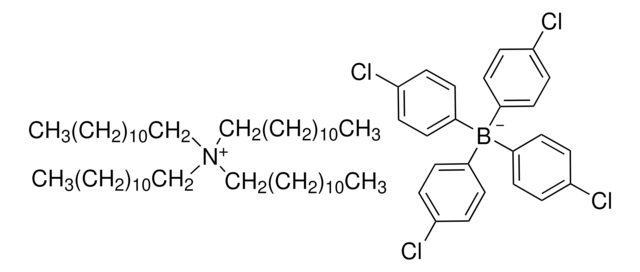60591
Potassium tetrakis(4-chlorophenyl)borate
Selectophore™, ≥98.0%
Sinónimos:
Tetrakis(4-chlorophenyl)boron potassium
About This Item
Productos recomendados
grado
for ion-selective electrodes
Nivel de calidad
Línea del producto
Selectophore™
Ensayo
≥98.0% (AT)
≥98.0%
Formulario
solid
cadena SMILES
[K+].Clc1ccc(cc1)[B-](c2ccc(Cl)cc2)(c3ccc(Cl)cc3)c4ccc(Cl)cc4
InChI
1S/C24H16BCl4.K/c26-21-9-1-17(2-10-21)25(18-3-11-22(27)12-4-18,19-5-13-23(28)14-6-19)20-7-15-24(29)16-8-20;/h1-16H;/q-1;+1
Clave InChI
SAGICZRAKJSWLD-UHFFFAOYSA-N
¿Está buscando productos similares? Visita Guía de comparación de productos
Descripción general
Aplicación
Envase
Información legal
Palabra de señalización
Danger
Frases de peligro
Consejos de prudencia
Clasificaciones de peligro
Acute Tox. 3 Oral
Código de clase de almacenamiento
6.1C - Combustible acute toxic Cat.3 / toxic compounds or compounds which causing chronic effects
Clase de riesgo para el agua (WGK)
WGK 3
Punto de inflamabilidad (°F)
Not applicable
Punto de inflamabilidad (°C)
Not applicable
Equipo de protección personal
dust mask type N95 (US), Eyeshields, Gloves
Elija entre una de las versiones más recientes:
¿Ya tiene este producto?
Encuentre la documentación para los productos que ha comprado recientemente en la Biblioteca de documentos.
Los clientes también vieron
Nuestro equipo de científicos tiene experiencia en todas las áreas de investigación: Ciencias de la vida, Ciencia de los materiales, Síntesis química, Cromatografía, Analítica y muchas otras.
Póngase en contacto con el Servicio técnico
![Sodium tetrakis[3,5-bis(trifluoromethyl)phenyl]borate Selectophore™](/deepweb/assets/sigmaaldrich/product/structures/251/439/7a621e74-bfd1-4a43-833c-09adfcc1e0b3/640/7a621e74-bfd1-4a43-833c-09adfcc1e0b3.png)


![Potassium tetrakis[3,5-bis(trifluoromethyl)phenyl]borate Selectophore™](/deepweb/assets/sigmaaldrich/product/structures/631/130/b5486f44-2e69-40d0-902f-dd71894a6add/640/b5486f44-2e69-40d0-902f-dd71894a6add.png)







